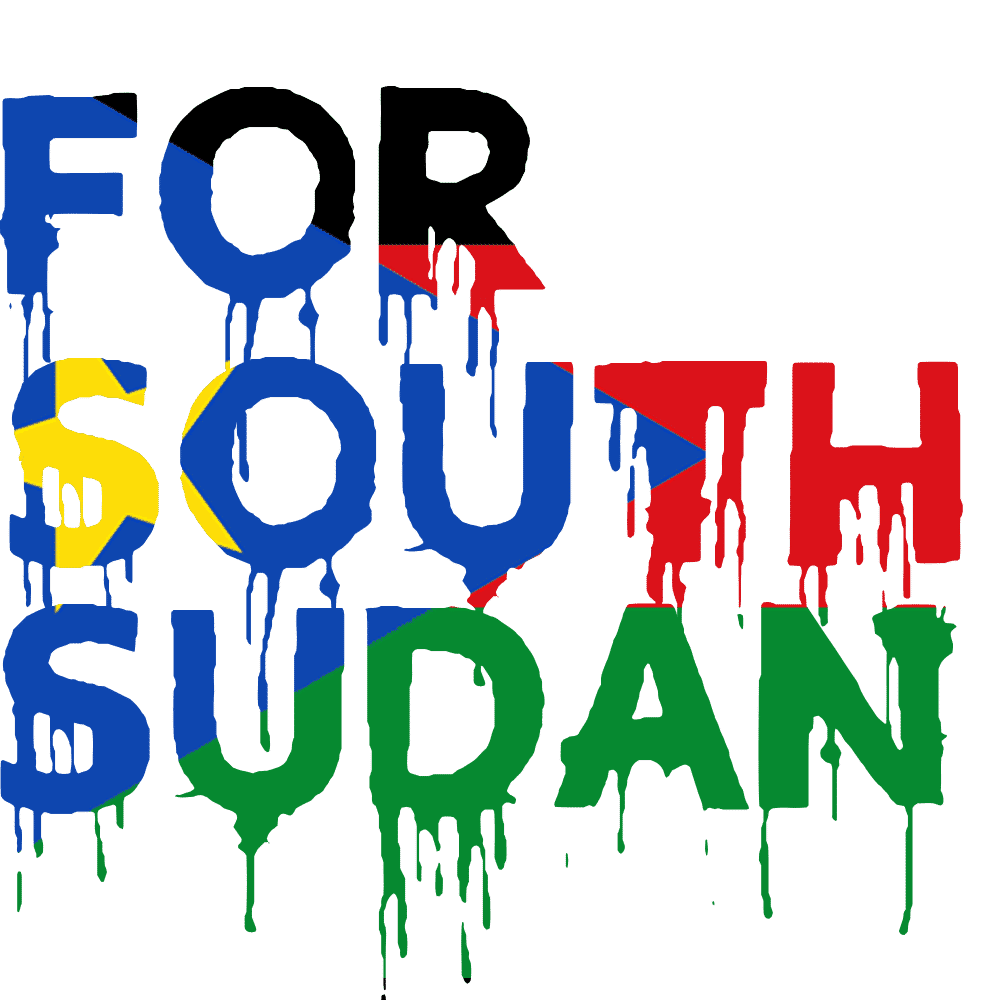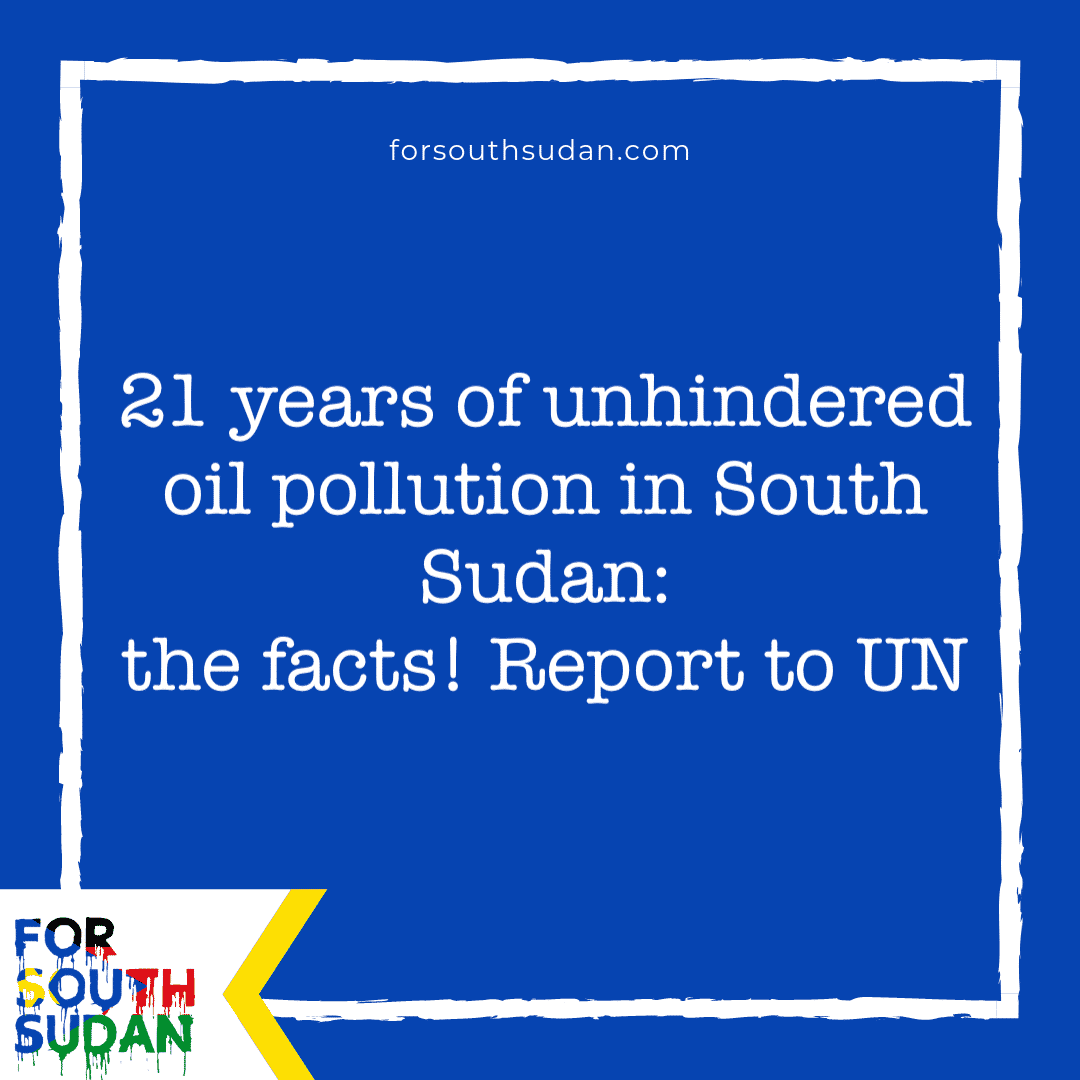https://undocs.org/pdf?symbol=en/A/HRC/46/NGO/94
On February 22, 2021, Sign of Hope, the Germany-based humanitarian and environmental NGO, submitted its report “Calculation of environmental contamination from oil production in South Sudan”.
it details a sheer unimaginable ravaging of human and environmental health by oil companies – notably China National Petroleum and Petronas of Malaysia – and their allies in the government.
Key findings: Oil production in South Sudan 1999 – 2020 released following gigantic amounts of contaminating fluids into the country’s environment:
1.36 trillion (1,362,519,667,348) litres of produced (poisoned) water containing a total of 8.31 million (8,310,007) tons of salt;
7.90 billion (7,896,000,000) litres of oil well drilling fluids containing a total of 1.18 tons of chromium, 12.05 tons of lead, 2.53 tons of nickel, 1.39 tons of cadmium, and 437,806.88 tons of salt
At least six million (6,000,000) litres of crude oil spilled.
And all of these fluids and contaminants were issued into the environment with no or circumspect prior treatment.
Full report:
Calculation of environmental contamination from oil productionin South Sudan 1999-2020
Sign of Hope e.V. -Hoffnungszeichen (Sign of Hope)wishes to draw the attention of the United Nations Human Rights Council to the violations of basic human rights by means of gross environmental pollution by the crude oil producing consortia in South Sudan.Sign of Hope calculated the total amount of contaminating fluids that were released into South Sudan’s environment between 1999 and 2020.
According to Sign of Hope’s calculations and estimates, they amount to 1.36 trillion (1,362,519,667,348) litres of produced water containing a total of 8.31 million (8,310,007) tons of salt; 7.90 billion (7,896,000,000) litres of oil well drilling fluids containing a total of 1.18 tons of chromium, 12.05 tons of lead, 2.53 tons of nickel, 1.39 tons of cadmium, and 437,806.88 tons of salt; and at least six million (6,000,000) litres of crude oil spilled.
According to Sign of Hope’s findings these contaminants have been released into the environment with no or negligible prior treatment.
Such amounts of contaminants entering the environment severely affect the communities inhabiting the oil producing regions. A poisoned environment deprives them of their human rights to clean water, health, and life. The responsibility for the contamination and for its consequences is shared by the government and by the oil industry in South Sudan. Sign of Hope calculated and estimated the contamination amounts in light of the history of official belittlement and inaction pertaining to mass pollution and its harm to humans and the environment.
Contamination calculation
Sign of Hope calculated contamination amounts on the basis of official statistics and of the samples we have taken from contamination sources on site. As to our account there are three major sources of environmental contamination from oil production in South Sudan: (1) produced water, (2) drilling fluids, and (3) oil spills. Air pollution is not included in the figures at hand.
1. Produced Water amounts
Produced water amounts are calculated on the basis of crude oil produced on the territory of South Sudan between 1999 and 2020. To calculate total oil production amounts we summed the official numbers of barrels per day published by the three major oil producing consortia: Greater Pioneer Operating Company (GPOC), Sudd Petroleum Operating Company (SPOC) and Dar Petroleum Operating Company (DPOC). We calculated a total of 1,512,354,137 barrels (240,444,647,179 litres) of crude oil produced in the whole of South Sudan between 1999 and 2020.
Produced water is a mixture of water, sand, salts and chemicals ensuing as a by-product from the extraction of oil. Produced water is separated from crude oil upon extraction. To calculate the amount of produced water we assumed the average water cut to be 85 %.
A water cut of 85 % means that each produced litre of oil is accompanied by 5.67 litres of produced water. This figure is based on the March 2010 well test records of 31 oil wells in the GPOC concession area. Thus, for 1999-2020 we calculated a total of 8,570,006,776 barrels (1,362,519,667,348 litres) of produced water in South Sudan. It is this amount of produced water, which has entered the environment in South Sudan, either unfiltered, or passing through a so called bioremediation plant. However, as to our findings, the bioremediation system used in South Sudan can neither remove salts nor heavy metals from produced water. In a sample of produced water taken at an SPOC facility, one litre of produced water contained 6099 mg/l of total dissolved solids. This multiplied with the overall amount of produced water results in a total of 8,310,007 tons of salt released into the environment in South Sudan between 1999 and 2020.
Moreover, elevated amounts of barium were found in produced water, which may be an indicator for the presence of radium. Radioactivity levels in produced water need to be measured.
2.Drilling fluid amounts
Drilling fluid amounts are calculated on the basis of the overall number of oil wells. The number of wells officially communicated by the three oil consortia sums up to at least 1,410. In the oil fields, close to each drilled well there is an open mud pit, into which drilling fluids –toxic chemicals used to facilitate the drilling process –are dumped. We calculated the volume of an average mud pit to be 5,600 m³. We estimated that each mud pit is completely filled only once. The overall amount of drilling fluids in all of the pits taken into account is thus 7,896,000,000 litres.
To estimate heavy metal amounts in drilling fluids we based our calculation on three drilling fluid samples taken at two different oil drilling sites in the SPOC concession area. Extrapolating from these samples we calculated the total amount of heavy metals: We estimate that 1.18 tons of chromium, 12.05 tons of lead, 2.53 tons of nickel, 1.39 tons of cadmium, and 437,806.88 tons of salt contained in the drilling fluids have been dumped into open mud pits across South Sudan in the last twenty years.
Sometimes these pits were lined with plastic sheets. Often they were not. As the Government of South Sudan and the oil industry could not provide a documentation process of drilling fluid disposal so far, we assume that these calculated immense amounts of toxins were disposed of into the environment untreated.
3.Oil spill amounts
There is no official source on oil spill accidents in South Sudan. Sign of Hope does not claim to report all spill incidents here. Yet, analysing satellite imagery Sign of Hope detected and calculated the amounts of two major terrestrial oil spills in consequence of export pipeline ruptures in the concession area of GPOC.The first oil spill took place some 40 km north of Rubkona, at N 9°36’49.83’’; E 29°37’36.83’’ on or about August 24, 2019. We measured the surface oil cover to be 10,000 m2 at least. On the basis of information provided by our agents on the ground, we estimated the average oil layer thickness to be 20 cm. We calculated the amount of oil spilled at around 12,500 barrels, which equals around 2,000,000 litres.
The second oil spill took place some 33.5 km north of Rubkona, at N 9°33’33.16’’; E 29°38’42.85’’ on or about October 28, 2019. We measured the surface oil cover to be some 20,000 m². We calculated the amount of oil spilled at around 25,000 barrels, which equals around 4,000,000 litres. Thus, we state the total amount of oil recently spilled into the environment to be at least 37,500 barrels or 6,000,000 litres.
Impacts on Environment and Human Health
Pollution from oil production significantly affects the quality of water,air, soil and consequently human health. Produced water seeps into the upper drinking water layer substantially elevating salt concentration in drinking water.1This endangers the sensitive eco-system of the Sudd wetlands, which is to be protected under the Ramsar Declaration. Ponds and pits containing produced water or drilling fluids constitute a hazard as their contents seep into the ground. Besides they are at risk to be flooded during rainy season. Entering the environment in vast amounts, produced water turns drinking water inconsumable for humans and live-stock.1Rueskamp, Hella; Ariki, John; Stieglitz, Klaus; Treskatis, Christoph (2014): Effect of oil exploration and production on the salinity of a marginally permeable aquifer system in the Thar Jath-, Mala-and Unity Oilfields, Southern Sudan. Zentralblatt für Geologie und Paläontologie 1: 95–115.A/HRC/46/NGO/944
The total amount of chemicals in the drilling fluids is highly toxic to the environment. They enter human bodies via food and water, and accumulate, as shown in our study covering hair analyses of affected oil field residents.2 Oil spills contaminate the environment and water bodies permanently, hence biodiversity decreases. Spilled oil destroys drinking water resources and fertile soil for pasture and agriculture, livestock dies. Oil fields residents report frequent diseases, blindness, infertility, miscarriages and disabilities.
Recommendations
The United Nations Human Rights Council should urge the Government of South Sudan to:
• Provide all oil field residents with clean water as well as infrastructure and medical treatment for contaminated humans and livestock;
• Instruct the oil producing companies to remove and dispose of production waste and spilled oil in such a manner that it does not endanger human health or environment, and to publicly document the waste disposal process;
• Ensure a comprehensive, transparent, unbiased and participatory environmental audit.The Government should conduct and publish all Environmental Impact, Social Impact and Strategic Environmental Assessments and protect the environment by law;
• Take broad measures to assess the damage and to bring about the remediation of environment and the compensation of those, whose lives and livelihoods have been affected by contamination caused by oil production – as stipulated in South Sudan’s Petroleum Act of 2012



